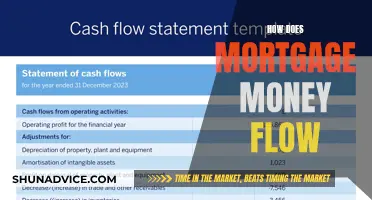
Assuming a mortgage is a home financing option that allows a buyer to take over the seller's mortgage loan and its terms, including the interest rate, repayment period, and principal balance. This can be an attractive option for buyers in a high-interest-rate market as it allows them to take advantage of a lower interest rate than what is currently available. However, it is important to note that not all mortgages can be assumed, and there are specific requirements and approval processes that need to be met. The two main ways to assume a mortgage are novation and simple assumption, with novation being the safer option as it requires the lender's approval.
Characteristics and Values of Assuming a Mortgage
| Characteristics | Values |
|---|---|
| Definition | A type of home financing arrangement where an outstanding mortgage and its terms are transferred from the current owner to the buyer. |
| Types | Novation (the safest type) and Simple Assumption (less common) |
| Qualifying Factors | Credit and finances, income and credit score requirements, and approval from the USDA/FHA/VA |
| Interest Rate | Fixed interest rate that is not impacted by rising interest rates |
| Closing Costs | Lower than the 2% to 6% typically paid to close a loan |
| Time to Close | Longer than a traditional mortgage, around 45 to 90 days |
| Appraisal Requirement | No appraisal required, saving buyers hundreds of dollars |
| Lender Approval | Required for most types of loans, except for VA loans closed before March 1, 1988 |
| Lender Liability | The seller may still be liable for payments if the buyer defaults |
| Use Cases | Divorce, inheritance, estate planning, gifts of real estate, foreclosure avoidance |
| Advantages | Lower interest rate, lower closing costs, no appraisal requirement, negotiating power for the seller |
| Disadvantages | Challenging process, higher price, potential liability for the seller, may require additional cash |
What You'll Learn

Pros and cons of assuming a mortgage
Assuming a mortgage means taking on the seller's existing home loan and its terms, including the interest rate, repayment period, and balance. This can be an attractive option for buyers in a high-interest-rate environment, as they can benefit from lower interest rates on the seller's loan.
Pros of Assuming a Mortgage
Assuming a mortgage has several advantages, including:
- Lower Interest Rates: Buyers can take advantage of lower interest rates if the seller's loan has a fixed interest rate that is lower than current market rates. This can result in significant savings over the life of the loan.
- Cost Savings: Assumable mortgages may have lower closing costs compared to traditional loans, which typically range from 2% to 6%. Government-backed loans, such as FHA, VA, and USDA loans, have capped closing costs.
- No Appraisal Requirement: Assumable mortgages typically do not require a new home appraisal, saving buyers hundreds of dollars. However, it is still recommended to get a home inspection to check for any repair issues.
- Avoidance of Foreclosure: For homeowners facing mortgage default, allowing a buyer to assume their mortgage can help them avoid foreclosure.
- Transfer of Assets: After a death or divorce, assumable mortgages can facilitate the transfer of assets without the need for lender approval.
Cons of Assuming a Mortgage
There are also several potential disadvantages to assuming a mortgage:
- Limited Loan Options: Not all types of mortgage loans are assumable. Conventional loans backed by Fannie Mae and Freddie Mac are generally not assumable, although there may be exceptions for adjustable-rate mortgages.
- High Down Payment: If the home's purchase price exceeds the mortgage balance, buyers may need to make a large down payment or obtain a separate mortgage to cover the difference. This can be a significant drawback, especially for buyers with good credit who could qualify for lower down payments on conventional loans.
- Risk of Default: In the case of a simple assumption (without lender approval), if the buyer defaults on the loan, both the buyer and seller may be held liable. This can negatively impact the seller's credit and bank balance.
- Delinquent Payments: Even if all requirements are met, the mortgage cannot be assumed if the seller is delinquent on payments.
- Mortgage Insurance: FHA and USDA loans require mortgage insurance premiums, which can increase the overall cost of the loan.
- Longer Processing Time: Assumable mortgages typically take longer to process, with a timeframe of around 45 to 90 days compared to 30 to 45 days for a traditional mortgage.
Mortgages: Impacting Your Balance Sheet and Financial Stability
You may want to see also

How to assume a mortgage
Assuming a mortgage is a home financing arrangement where an outstanding mortgage and its terms are transferred from the current owner to the buyer. This means that the buyer takes on the original loan balance, interest rate, repayment period, and any other contractual terms of the seller's mortgage. By assuming the previous owner's remaining debt, the buyer can avoid obtaining their own mortgage, which may come with higher interest rates.
There are two main ways to assume a mortgage: novation and simple assumption. Novation is the safest and most common type, where the lender agrees to let the buyer take responsibility for the existing mortgage. The buyer is put through the underwriting process before receiving the lender's approval, and the seller is released from all future responsibility for the mortgage payments. Simple assumption, on the other hand, is a private transfer of responsibility from the seller to the buyer without the mortgage lender's approval. This is a much riskier transaction because if the buyer fails to make payments, both the buyer and seller are liable.
To assume a mortgage, the buyer must meet specific requirements and receive approval from the agency sponsoring the mortgage. For example, FHA loans are assumable when the property is the seller's primary residence, and the buyer must meet standard FHA loan requirements, such as a minimum credit score of 580. USDA loans require the buyer to meet credit and income requirements and receive approval from the USDA. VA loans are also assumable, and while the buyer doesn't need to be a military member, the lender and regional VA loan office must approve the loan assumption.
It's important to note that assuming a mortgage does not account for any home equity the seller has built. If the house has gained value since the original loan, the buyer must compensate the seller for the equity. Additionally, while government-backed loans are typically assumable, most conventional loans are not.
Understanding Rental Property Mortgage Debt on Your FAFSA
You may want to see also

The different types of assumable mortgages
An assumable mortgage is a type of home loan that can be transferred from the current owner to the buyer. This allows the buyer to take over the seller's loan, including the remaining balance, repayment schedule, and interest rate. Typically, only government-backed mortgages can be assumed, and they are subject to approval by the lender.
There are three main types of assumable mortgages: VA loans, FHA loans, and USDA loans. VA loans are backed by the Department of Veterans Affairs and are available to qualified military members, veterans, and their spouses. FHA loans are guaranteed by the Federal Housing Administration, and USDA loans are offered by the U.S. Department of Agriculture.
VA loans originated before March 1, 1988, can be assumed without the approval of the lender or the VA. However, sellers may still be liable for making payments if the buyer defaults. USDA loans also do not require a down payment and are assumable with the approval of the lender and the USDA.
FHA loans are assumable when both the buyer and seller meet the requirements, such as the property being used as the primary residence. The buyer must also meet the lender's criteria and receive approval from the agency sponsoring the mortgage.
In addition to these three main types, some conventional loans may also qualify as assumable mortgages, depending on their terms and conditions. However, conventional loans typically contain a due-on-sale clause, which allows the lender to demand the full loan amount when the property is sold.
Understanding the Mortgage Process: A Step-by-Step Guide
You may want to see also

The costs of assuming a mortgage
Assuming a mortgage can be an attractive option for buyers, especially when current mortgage rates are high. However, there are several costs and considerations to keep in mind when exploring this option.
Firstly, it is important to understand that assuming a mortgage means taking on the existing loan balance and its original terms, including the interest rate, repayment period, and current principal balance. This can be advantageous if the assumed mortgage has a lower interest rate than what is currently available on the market. However, if the house has gained value since the original loan was issued, the buyer may need to compensate the seller for the equity they have built. This can result in a higher down payment or the need for a second mortgage to cover the balance.
There are also assumption fees associated with taking on a mortgage. These fees vary depending on the type of loan. For conventional loans, the assumption fee is typically a percentage of the loan amount, while for FHA loans, it is capped at $1,800, and for VA loans, it is a maximum of $300. Additionally, government-backed loans may have other associated costs, such as funding fees for VA loans and real estate transfer taxes, depending on the state.
The process of assuming a mortgage may also involve closing costs, which can range from 2% to 6% of the loan amount. However, it is important to note that closing costs for assumed government-backed loans are generally lower than those for traditional loans. The specific fees and costs will depend on the type of loan and the requirements of the lender.
Furthermore, assuming a mortgage may involve ongoing mortgage insurance payments, which can add to the overall cost of the loan. It is important for buyers to carefully review the loan agreement and understand all the associated costs and fees before proceeding with assuming a mortgage.
Lastly, it is worth mentioning that assuming a mortgage can be a complex and challenging process. Buyers will need to meet certain qualifications, including creditworthiness and income requirements, and receive approval from the lender and, in some cases, the agency sponsoring the mortgage (such as USDA, FHA, or VA). The approval process can be lengthy, and until the seller is released from the loan, they may still be responsible for the payments.
The Best Time to Apply for a Mortgage
You may want to see also

Who can assume a mortgage
An assumable mortgage is a type of home financing arrangement where an outstanding mortgage and its terms are transferred from the current owner to the buyer. The buyer can take over the seller's home loan payments and interest rate, repayment period, and current principal balance. This means that the buyer does not need to obtain their own mortgage, which may carry a higher interest rate.
There are two ways to assume a mortgage: novation and simple assumption. Novation is the safest type, where the lender agrees to let the buyer take responsibility for the existing mortgage. The less common way is simple assumption, where responsibility for the mortgage is transferred from the seller to the buyer without the mortgage lender's approval.
USDA, FHA, and VA loans are assumable when certain criteria are met. For example, to assume a USDA loan, you must meet the standard qualifications, such as credit and income requirements, and receive approval from the USDA to transfer the title. For FHA loans, you'll need to meet the standard FHA loan requirements. For VA loans, you don't need to be a member of the military or a veteran, but if the loan originated after 1988, any loan assumption must be lender-approved.
Lower Fees, Bigger Benefits: Refinancing Your Mortgage
You may want to see also
Frequently asked questions
An assumable mortgage is a home loan that can be transferred from the original borrower to the subsequent homeowner. The buyer takes on the original loan balance at the original terms, including the interest rate and repayment period.
An assumable mortgage can be attractive to buyers when the existing mortgage rate is lower than current market rates. It also allows the buyer to avoid obtaining their own mortgage, which may come with higher interest rates. Closing costs on assumed government-backed loans are also cheaper than the 2% to 6% you'd normally pay to close a loan.
There are two main ways to assume a mortgage: novation and simple assumption. Novation is the safest type, where the lender agrees to let the buyer take responsibility for the existing mortgage. Simple assumption is a private transfer of responsibility without the lender's approval, which is much riskier.







